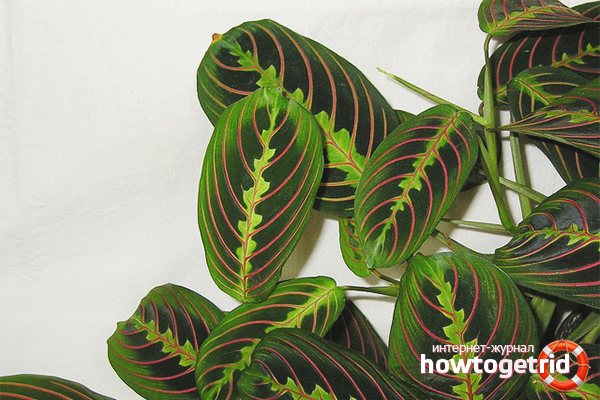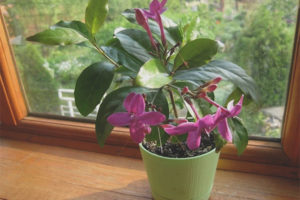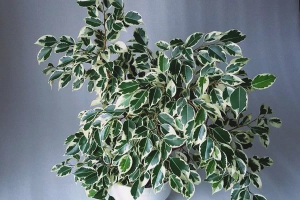The content of the article
Maranta is a favorite plant of many gardeners. Arrowroot is quite unpretentious in care, grows well in any conditions. This indoor flower raises leaves up in the evening and blossoms again in the morning. For such an unusual property, Maranta was called the "prayer plant." Arrowheads are decorated with brown spots in the amount of 10 pieces. That is why, associating this plant with religion, the flower has another name “ten commandments”.
The flower was named after the famous botanist and scientist Bartolemeo Maranta, who helped people and treated them with herbs. The leaves of the plant are a real work of art - the shades gently interweave with each other, creating unusual patterns and weaves. The color of the leaves can vary from white to dark green, with red and burgundy veins. Arrowroot blooms in small flowers, which can be white, cream or purple. Many flower growers believe that arrowroot flowers cannot be compared in beauty with its leaves, so they immediately remove the inflorescences so that the plant does not waste strength on them.
Maranta is a medium-tall plant, it rarely reaches growth above 40 cm. This unpretentious flower grows well in breadth and, with proper care, appears before a person in all its glory.
Species of the arrowroot plant
The arrowroot flower has more than 25 species, depending on the color and shape of the leaves. Here are some of the most common types:
- Arbor stranger is most common. The leaves are dark green, the central core is silver. On the sides are white stripes.
- Red-stalked arrowroot. The color of the leaves varies in all shades of green. A red line goes along the edge of the leaves, which becomes burgundy or pink. Feather-shaped leaflets.
- Maranta Kerkhovina has oval leaves on short cuttings. Green leaves with a white stripe in the center. On the reverse side, the leaves may be pink or bluish.
- Reed arrowroot. The color is similar to other varieties of arrowroot, but the edges of the leaves have a wavy shape. Reed arrowroot grows in dense shrubs.
- Arrowroot masange has a dark leaf color - from black to olive.
How to care for the arrowroot
In order for a person, plant or animal to feel good, to grow and multiply with pleasure, they need to create comfortable living conditions for them. Here are some tips for creating a comfortable environment for growing arrowroots.
- Arrowroot is quite a water-loving plant. The earth in the pot of this flower should always be wet. The frequency of watering depends on the season and the humidity level in the room. The arrowroot is usually watered a couple of times a week, in the hot summer months - every other day.
- Tropical arrowroot is best planted in expanded clay tray with water.
- Maranta must be sprayed with water from a spray bottle. From this her leaves become lively and moisturized.
- Water for irrigation and spraying arrowroot should be at room temperature. It is not allowed to water the plant with hot or cold water. It is best to water the plants with settling water so that there are no impurities in it.
- The arrowroot must not be watered with water containing chlorine or lime - it dies from this.
- The arrowroot plant is shade-loving. You should not put a flower pot in direct sunlight, especially in the summer and spring months.
- The optimum temperature for the growth of arrowroot is from 16 to 25 degrees. The flower does not tolerate frost and sudden changes in temperature.Equally important is the humidity of the room in which the arrowroot grows. In the winter months, when radiators and batteries dry the air, additional hydration of the flower is necessary.
- Maranta does not like drafts, so placing the plant on the windowsill is not entirely correct. Also, there should be no foreign plants near the flower pot, at least at a distance of 20 cm. Maranta grows well if it is not blocked by anything.
How to transplant arrowroot
Once every two years, this plant requires a transplant, because the roots become crowded in the previous pot. The new pot should not differ much from the previous one - in the large earthen space the arrowroot grows worse.
Before transplanting, the plant needs to be prepared. Cut off all dull and wilted leaves and some shoots. The flower should spend its energy on new shoots, and not on the restoration of wilted leaves. If you want the arrowroot to stretch in height, cut off the side young shoots. If you want to get a more sprawling and lush plant, it is better to cut the flower on top.
When preparing a new pot, pour expanded clay on the bottom so that the roots of the plant do not rot in the remaining water from irrigation. The lower layer must be filled with soil with low acidity. To do this, mix one part of sand, two parts of peat and three parts of ordinary soil. Pour some crushed coal into the ground, and then plant a lump of earth with a plant. Fill the spaces between the roots of the plant and the walls of the pot with plain earth.
How to feed an arrowroot
In order for the arrowroot to be beautiful, magnificent and sprawling, it needs to be fertilized. The plant is especially in need of top dressing in spring and summer, during the period of active growth and flowering. You can fertilize the arrowroot with special mineral complexes that you can buy in the store of decorative indoor plants.
Fertilize the plant once every two weeks. Dissolve a piece of mineral complex the size of a match head in a liter of clean water and water the plant with it. After two weeks, you can pour the same composition that remained in the bottle - it is not necessary to breed a new portion. However, be careful - do not overdo it. An excess of mineral fertilizers can lead to the death of the plant.
Arrowroot propagation
Arrowroot can be propagated in several ways. First, the division of the roots. When replanting a plant, divide the roots into two or three parts. Note that each root system must be viable. After this, the roots of the plant are placed in water or immediately planted in a pot (if the roots are sufficiently developed). After this, the arrowroot needs plentiful watering during the first weeks. Further, the plant develops, as usual.
If the plants are still far from transplanting, and the flower needs to be propagated, you can do this by the method of cuttings. Cut a viable stalk of 10-12 cm from the plant. Young shoots that we remove when pruning take root well. The cutlery should be placed in water so that the branch gives roots. When measles are tied up at the arrowroot, it can be transplanted into a pot of soil. Cover it on top with plastic wrap to create an imitation of a greenhouse. In such conditions, the plant is taken better. Cuttings cut off from May to September are best taken root.
Diseases and Pests
The plant has no particular pests and diseases. Typically, arrowroot has two enemies - mealybugs and spider mites. The mealybug is localized on the petioles of the plant. To get rid of it, you need to wipe the flower trunk with soapy water. After processing, rinse the flower thoroughly with clean water so that there are no soap residues on it.
The presence of spider mites can be determined by the thin web, which is formed on the wrong side of the leaves of the plant. In this case, the plant loses its lower leaves, becomes lethargic. The spider mite infects plants with too low humidity in the room.To get rid of this, you need to cut off all infected leaves and treat the arrowroot with a bacteriological composition, which can be bought in a specialized store. It is designed specifically for decorative indoor plants - ruthless to pests and delicate with plants.
Arrowroot Care Questions
Here are the main problems that flower growers face in growing the arrowroot plant.
Why does the arrowroot dry? Arrowroot can dry for several reasons. One of the main ones is a lack of moisture. If you do not water the plant often enough, if you do not spray the leaves, the lower leaves may turn yellow, and the upper leaves may dry at the ends. Arrowroot may dry out due to excessive amounts of lime in the soil. Check it out is easy. Pour a little soil on a plate and pour the vinegar over the soil. If the earth began to foam, then there is a lot of lime in it. Arrowroot may become covered with brown spots if the room where the flower grows has low humidity.
Why do arrowheads curl leaves? Almost any change in the flower is the cause of improper care of it. Maranta rolls leaves before every night, and in the morning it opens again. If the leaves remain twisted throughout the day, then the plant is just cold. Place it in a room with a higher temperature so that it "comes to life".
Why does arrowroot change the color of leaves? If the leaves of the plant have become faded, dull or yellow, then something in the care is going wrong. Try to move the plant to a warmer room, eliminate drafts, increase the frequency of watering. Perhaps the arrowroot changes the color of its leaves because it lacks nutrients - remember how long you fed the plant.
Decorative indoor flowers - like children. They require attention, care, care and love. Create your plants comfortable living conditions so that they please you with active growth and lush flowering.
Video: arrowroot care












Submit